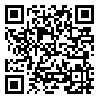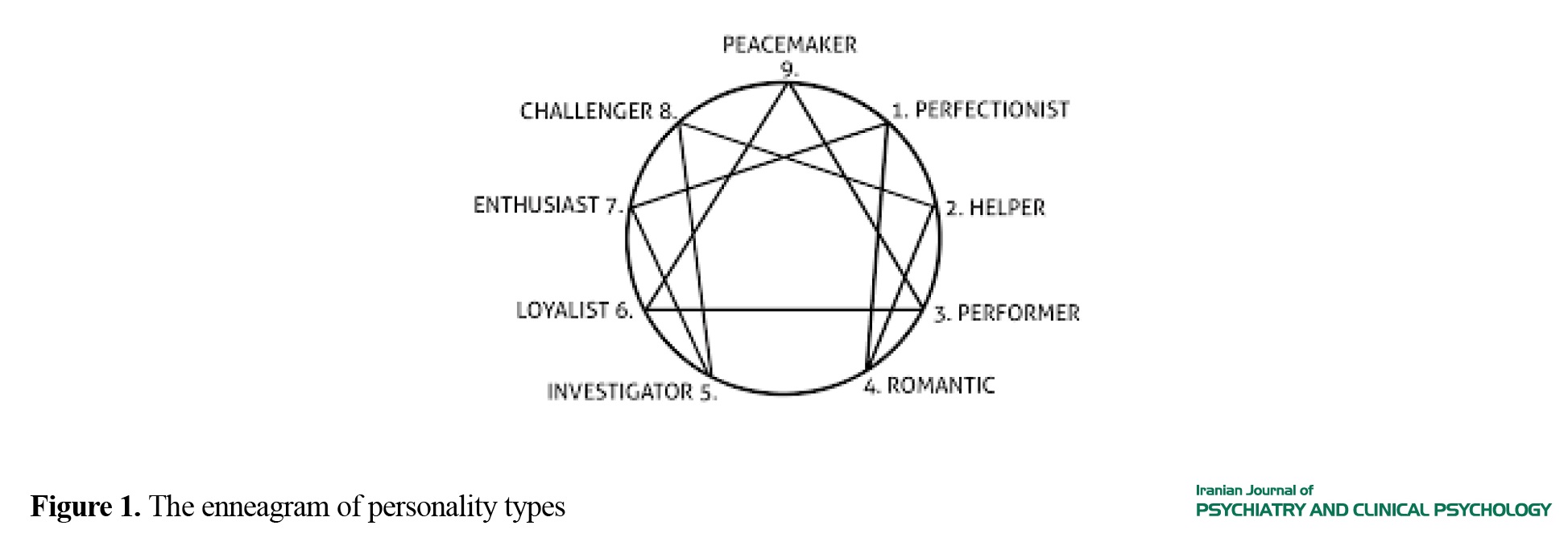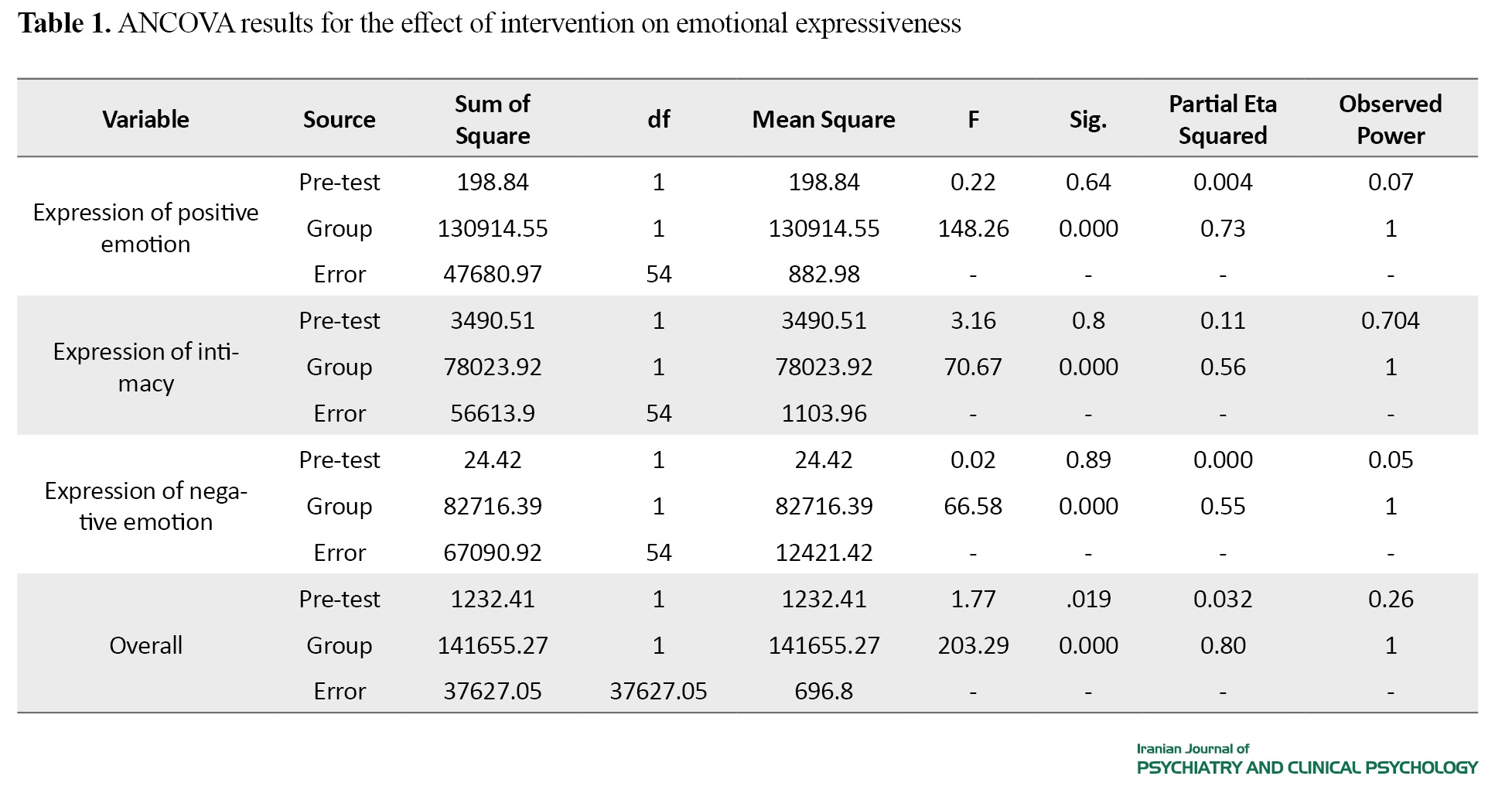BibTeX | RIS | EndNote | Medlars | ProCite | Reference Manager | RefWorks
Send citation to:
URL: http://ijpcp.iums.ac.ir/article-1-3036-en.html
2- Department of General Psychology, Faculty of Education & Psychology, Islamic Azad University, Isfahan (Khorasgan) Branch, Isfahan, Iran. ,
1. Introduction
Premarital preparation course is a new approach to prevent and eliminate dissatisfaction with marriage, where couples learn how to have a successful and lasting matrimony. Accordingly, premarital counseling is an educational, therapeutic, and preventive method. Preventive approaches have two major goals: improving family life and preventing divorce. The theories and models proposed in the field of marriage clarifies that various factors affect the stability of marriage. One of the most important factors is the personality traits of couples. On the other hand, maintaining romantic and satisfying relationships requires the ability to recognize and express emotions. Emotional expressiveness refers to a facial movement, bodily behavior, or verbal expression that communicates an emotional state in a special and reliable way.
Previous studies suggest that emotional expression is associated with the individuals’ personality traits. One of the new topics in the field of typology in psychology, especially in Iran is the nine-personality types known as “enneagram”. It is a system consisting of nine personality types that addresses the strengths and weakness of each type and provides a global language that helps people better understand themselves and others. The enneagram diagram consists of a triangle and a hexagon enclosed within a circle. The combination of these elements creates nine points along the circle. Each of these nine points provides a strategy for interacting with the environment which affects personality and identifies nine distinct personality types (Figure 1).
The study of emotional expression in couples applying for marriage is important, theoretically and functionally, because our greater understanding of the personality traits that influences emotional expression can lead to a better understanding of this phenomenon, especially in the premarital phase. To the best of our knowledge, no enneagram-based interventional program has been developed to affect the emotional expression of couples. Thus, the present study is the first study aimed to develop an educational package based on enneagram types to affect the emotional expressiveness of couples preparing for marriage.
2. Methods
Study subjects
This quasi-experimental study was conducted on 30 couples in premarital phase selected using a convenience sampling technique and randomly assigned into intervention and control groups, after meeting the inclusion and exclusion criteria. The inclusion criteria were: having a high school degree, not attending other premarital educational courses before entering the study, age 20-35 years, and no previous marriage and training. The exclusion criteria including: absent for more than two training session, being under both training and counseling, and having any mental disease that can prevent attending training sessions according to Diagnostic and Statistical Manual of Mental Disorders, 5th Edition (DSM-5) criteria diagnosed by a psychiatrist. The subjects in both groups completed the Emotional Expressiveness Questionnaire (EEQ) before the study, and 45 days after the end of intervention. The educational package was presented to the intervention group at ten 90-min sessions once a week. The control group received no information but was informed to receive the package later.
Developing the educational Package
The enneagram-based educational package was developed based on the study literature, the emotional expression predictors, and existing enneagram principles provided by experts in Iran and other countries. Then, the objectives, contents, and assignments were evaluated. By combining and matching techniques and the related emotional expression components including behaviors, attitudes and views, needs and desires, fears and concerns, and defense mechanisms, a guideline was formulated entitled “A guide to the enneagram with a focus on emotional expression”, aiming to affect the emotional expressiveness of marriage applicants. Then, it’s the initial packages were distributed among five premarital consultants with a PhD degree in premarital education, and were asked to rate the structure and content of each session based on a Likert scale. The final version was then confirmed after modifications. Then, the effect of the designed package on the emotional expressiveness of couples was assessed using ANCOVA.
3. Results
The results indicated that the designed enneagram-based intervention could significantly affect the emotional expressiveness of the study couples. There was a significant difference between the scores of intervention and control groups after intervention (P<0.05) (Table 1).
4. Discussion
The enneagram-based educational package could significantly affect the behaviors, attitudes and views, needs and desires, fears and concerns, defense mechanisms and, consequently, the emotional expressiveness of couples. These findings support the results of previous studies. Since the enneagram-based tasks continued after the end of intervention and the couples were supposed to perform them at home, it was observed that after 45 days the improvements were significantly continued, indicating the stable effect of the educational intervention. It is suggested that further studies should be conducted tp compare the effect of enneagram-based educational package on the emotional expressiveness of couples with the effect of other personality-related educational tools.
Ethical Considerations
Compliance with ethical guidelines
This study obtained its ethical approval from the Research Ethics Committee of Islamic Azad University of Khorasgan branch (Code: IR.IAU.KHUISF.REC.1397.058). The participants were informed about the study objectives and methods and were also assured of the confidentiality of their information. They were allowed to leave the study at any time.
Funding
This study was extracted from the PhD. thesis of the first author approved by the Department of Psychology, Faculty of Psychology & Educational Science, Isfahan (Khorasgan) Branch, Islamic Azad University.
Authors contributions
Conceptualization, data analysis, project administration: All authors; Methodology: Mohsen Golparvar, Farnaz Navabifar; Investigation, resources, initial draft preparation, editing and review: Farnaz Navabifar.
Conflicts of interest
The authors declared no conflict of interest.
References
1.Kotrla K, Dyer P, Stelzer K. Marriage educatin with hispani couples: Evaluation of communication workshop. Family Science Review. 2010; 15(2):1-14.
https://www.semanticscholar.org/paper/Marriage-Education-with-Hispanic-Couples%3A-of-a-Kotrla-Stelzer/a8a8196c34e85ea543dc9779c1c6b4a149901a61?p2df
2.Doss BD, Rhoades GK, Stanley SM, Markman HJ, Johnson CA. Differential use of premarital education in first and second marriages. Journal of Family Psychology. 2009; 23(2):268-73. [DOI:10.1037/a0014356] [PMID]
3.Risch GS, Riley LA, Lawer MG. Problematic issues in the early years of marriage: Content for premarital education. Journal of Psychology and Theology. 2003; 31(3):253-69. [DOI:10.1177/009164710303100310]
4.Parhizgar O, Esmaelzadeh-Saeieh, S, Akbari Kamrani M, Rahimzadeh M, Tehranizadeh M. Effect of premarital counseling on marital satisfaction. Shiraz E-Medical Journal. 2017; 18(5):e13182. [DOI:10.5812/semj.44693]
5.Naderi F, Eftekhar Z, Amolla Zadeh S. [The correlations among personality characteristics and intimate relationships with couple burnout in spouses of addict men in Ahwaz (Persian)]. Journal of Social Psychology (New Findings in Psychology). 2009; 4(11):61- 78. https://www.sid.ir/Fa/Journal/ViewPaper.aspx?id=124229
6.Sepehrian-Azar F, Galavandee H. [The effect of enneagram training on decrease of marital conflict (Persian)]. Journal of Family Counseling & Psychotherapy. 2011; 1(2):161-70. https://www.sid.ir/fa/journal/ViewPaper.aspx?ID=149096
7.Brent Donnellan M, Conger RD, Bryant CM. Erratum to “The big five and enduring marriages” [Journal of Research in Personality 38 (2004) 481–504]. Journal of Research in Personality. 2005; 39(1):206-7. [DOI:10.1016/j.jrp.2004.10.001]
8.Luo Sh, Klohnen EC. Assortative mating and marital quality in newlyweds: A couple-centered approach. Journal of Personality and Social Psychology. 2005; 88(2):304-26. [DOI:10.1037/0022-3514.88.2.304] [PMID]
9.Claxton A, O’Rourke N, Smith JAZ, DeLongis A. Personality traits and marital satisfaction within enduring relationships: An intra-couple discrepancy approach. Journal of Social and Personal Relationships. 2012; 29(3):375-96. [DOI:10.1177/0265407511431183]
10.Abbasi R, Rasoulzadeh Tabatabaei SK. [Marital satisfaction and indivitual differences: The role of personality factors (Persian)]. International Journal of Behavioral Sciences. 2009; 3(3):237-42. https://www.sid.ir/fa/journal/ViewPaper.aspx?ID=99484
11.Mohammadi A, Sahaghi H , Neysi M, Rezaee Nia Z. [Providing a preliminary model of the happily marriage: A qualitative study (Persian)]. Rooyesh-e- Ravanshenasi Journal. 2016; 6(3):135-62. http://frooyesh.ir/article-1-472-en.html
12.Diefendorff JM, Richard EM, Yang J. Linking emotion regulation strategies to affective events and negative emotions at work. Journal of Vocational Behavior. 2008; 73(3):498-508. [DOI:10.1016/j.jvb.2008.09.006]
13.Feldman Barrett L, Adolphs R, Marsella S, Martinez AM, Pollak SD. Emotional expressions reconsidered: Challenges to inferring emotion from human facial movements. Psychological Science in the Public Interest. 2019; 20(1):1-68. [DOI:10.1177/1529100619832930] [PMID] [PMCID]
14.Konishi H, Froyen LG, Skibbe LE, Bowles RP. Family context and children’s early literacy skills: The role of marriage quality and emotional expressiveness of mothers and fathers. Early Childhood Research Quarterly. 2018; 42:183-92. [DOI:10.1016/j.ecresq.2017.10.008]
15.Pooralkhas Sh, Saljooghi Z. [Investigating the characters of the Miramar novel based on the Enneagram School (Persian)]. Paper presented at: 8th Conference on Persian Language and Literature Research. January 2016; Tehran, Iran. https://www.sid.ir/Fa/Seminar/ViewPaper.aspx?ID=31081
16.Daniels DL, Price VA. The essential Enneagram: the definitive personality test and self-discovery guide [N. Seyed Mohammadi, Persian trans]. Seyed Mohammadi Y, editor. Tehran: Arasbaran; 2016. http://opac.nlai.ir/opac-prod/bibliographic/4616314
17.Tallon R, Sikora M. Awareness to action: The Enneagram, emotional intelligence, and change. Scranton: University of Scranton Press; 2006. https://books.google.com/books?id=BrC6AAAACAAJ&dq
18.Daghighian P. [Psychology of nine personalities: Enneagram (Persian)]. 2nd ed. Tehran: Ashianeye Ketab; 2009. http://opac.nlai.ir/opac-prod/bibliographic/983829
19.King LA, Emmons RA. Conflict over emotional expression: Psychological and physical correlates. Journal of Personality and Social Psychology. 1990; 58(5):864-77. [DOI:10.1037/0022-3514.58.5.864]
20.Rafiei Nia P, Rasoulzadeh Tabatabaei SK, Azad Fallah P. [Relationship between emotional expression styles and general health in college students (Persian)]. Journal of Psychology. 2006; 10(1):84-105. https://www.sid.ir/fa/journal/ViewPaper.aspx?ID=49301
21.Memarzadeh M, Khodabakhshi-Koolaee A, Khatiban M. [The effect of training the nine Enneagram personality types on spouse selection criteria and marital attitude of single girls (Persian)]. Journal of Education and Community Health. 2017; 3(4):24-30. [DOI:10.21859/jech.3.4.24]
22.Carroll JS, Doherty WJ. Evaluating the effectiveness of premarital prevention programs: A meta-analytic review of outcome research. Family Relations. 2003; 52(2):105-18. [DOI:10.1111/j.1741-3729.2003.00105.x]
23.McGeorge CR, Carlson TS. Premarital education: An Assessment of program efficacy. Contemporary Family Therapy. 2006; 28(1):165-90. [DOI:10.1007/s10591-006-9701-8]
24.Arthur K, Allen K. The nature of love: Understanding the enneagram types as nine expressions of attachment. The Enneagram Journal. 2010; 3(1):6-22. http://iranenneagram.ir/wp-content/uploads/2017/03/iranenneagram.c022.pdf
25.Kashi G. [A survey of Enneagram training effectiveness on marital satisfaction of housewife self-esteeming in Tehran (Persian)] [MSc. thesis]. Tehran: Psychology of Al-Zahra University; 2010.
26.Keshavarz-Afshar H, Abdini F, Ghahvehchi F, Asadi M, Jahanbakhshi Z. [The role of emotional expressiveness and demographic factors in predicting marital satisfaction among women (Persian)]. Semi-Annual Journal of Family Pathology, Counseling & Enrichment. 2015; 1(1):59-66. http://fpcej.ir/article-1-106-fa.html
27.Kolak AM, Volling BL. Parental expressiveness as a moderator of coparenting and marital relationship quality. Family Relations. 2007; 56(5):467-78. [DOI:10.1111/j.1741-3729.2007.00474.x] [PMID] [PMCID]
28.Froyen LC, Skibbe LE, Bowles RP, Blow AJ, Gerde HK. Marital satisfaction, family emotional expressiveness, home learning environments, and children’s emergent literacy. Journal of Marriage and Family. 2013; 75(1):42-55. [DOI:10.1111/j.1741-3737.2012.01035.x]
29.O’Leary KD, Smith DA. Marital interactions. Annual Review of Psychology, 1991; 42:191-212. [DOI:10.1146/annurev.ps.42.020191.001203] [PMID]
30.Moslemi M, Aghaei H. [The effectiveness of training based on group narrative therapy on the couples intimacy (Persian)]. Journal of Psychoscience. 2017; 16(62):265-82. http://psychologicalscience.ir/article-1-152-en.html
31.Patrick Sh, Sells JN, Giordano FG, Tollerud TR. Intimacy, differentiation, and personality variables as predictors of marital satisfaction. The Family Journal. 2007; 15(4):359-67. [DOI:10.1177/1066480707303754]
32.de Veld DMJ, Marianne Riksen-Walraven J, de Weerth C. The relation between emotion regulation strategies and physiological stress responses in middle childhood. Psychoneuroendocrinology. 2012; 37(8):1309-19. [DOI:10.1016/j.psyneuen.2012.01.004] [PMID]
33.Baron KG, Smith TW, Butner J, Nealey-Moore J, Hawkins MW, Uchino BN. Hostility, anger, and marital adjustment: Concurrent and prospective associations with psychological vulnerability. Journal of Behavioral Medicine. 2007; 30(1):1-10. [DOI:10.1007/s10865-006-9086-z] [PMID]
Received: 2019/07/27 | Accepted: 2020/01/12 | Published: 2020/04/1
| Rights and permissions | |
 |
This work is licensed under a Creative Commons Attribution-NonCommercial 4.0 International License. |








